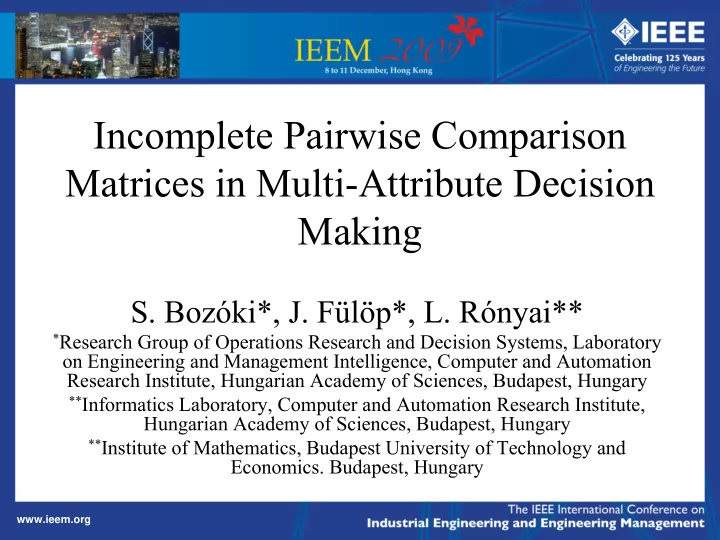

Incomplete Pairwise Comparison Matrices in Multi-Attribute Decision Making S. Bozóki*, J. Fülöp*, L. Rónyai** * Research Group of Operations Research and Decision Systems, Laboratory on Engineering and Management Intelligence, Computer and Automation Research Institute, Hungarian Academy of Sciences, Budapest, Hungary ** Informatics Laboratory, Computer and Automation Research Institute, Hungarian Academy of Sciences, Budapest, Hungary ** Institute of Mathematics, Budapest University of Technology and Economics. Budapest, Hungary www.ieem.org
Outline • Pairwise comparison matrix • Incomplete pairwise comparison matrix • Eigenvalue minimization • Incomplete Logarithmic Least Squares • Algorithms • Example www.ieem.org
Pairwise comparison matrix It is one of the most often applied technique in Multi-Attribute Decision Making for weighting the criteria and evaluation of the alternatives. Pairwise comparison matrix is a basic concept of the Analytic Hierarchy Process (AHP) developed by Thomas Saaty in 1977. www.ieem.org
Pairwise comparison matrix A (complete) pairwise comparison matrix A = [ a ij ] i,j=1,…,n is a matrix of size n×n with the properties as follows: a ij > 0; a ii = 1; a ij = 1/a ji for i,j=1,…,n , where aij is the numerical answer given by the decision maker for the question “How many times Criterion i is more important than Criterion j ?” The weighting problem is to find the n -dimensional positive weight vector w = (w 1 ) T ,w 2 ,…,w n such that the appropriate ratios of the components of w reflect, or, at least, approximate all the a ij values ( i,j=1,…,n ), given by the decision maker. www.ieem.org
Incomplete pairwise comparison matrix www.ieem.org
Incomplete pairwise comparison matrix • Harker (1987) • Kwiesielewicz (1996) • Shiraishi, Obata, Daigo (1997, 1998, 2002) • van Uden (2002) www.ieem.org
Undirected graph representation www.ieem.org
Directed graph representation www.ieem.org
Eigenvalue minimization problem min { λ max ( A ( x )) | x > 0 } www.ieem.org
Theorem 1: The optimal solution of the eigenvalue minimization problem is unique if and only if the graph G orresponding to the incomplete pairwise comparison matrix is connected . www.ieem.org
Theorem 2: The function λ max ( A ( x )) attains its minimum and the optimal solutions constitute an ( s – 1 )-dimensional affine set, where s is the number of the connected components in the graph corresponding to the incomplete pairwise comparison matrix. www.ieem.org
Incomplete LLSM www.ieem.org
Theorem 3: The optimal solution of the incomplete LLSM problem is unique if and only if graph corresponding to the incomplete pairwise comparison matrix is connected . Moreover, the solution is explicitly written. www.ieem.org
An 8x8 incomplete example www.ieem.org
An 8x8 incomplete example www.ieem.org
An 8x8 incomplete example www.ieem.org
Conclusions • The connectedness of the graph is necessary and sufficient for a unique solution of both eigenvalue minimization and logarithmic least squares problems for incomplete pairwise comparison matrices. • Algorithms are fast and simply implemented. • Applicable in practice. www.ieem.org
Main references 1 • S. Bozóki, J. Fülöp, and L. Rónyai, “On optimal completions of incomplete pairwise comparison matrices,” Working Paper 2009-1, Research Group of Operations Research and Decision Systems,Laboratory on Engineering and Management Intelligence,Computer and Automation Research Institute, Hungarian Academy of Sciences, 30 pages, 2009. • B. Aupetit, and C. Genest, “On some useful properties of the Perron eigenvalue of a positive reciprocal matrix in the context of the analytic hierarchy process. ,” European Journal of Operational Research, vol. 70; pp. 263–268, 1993. • G. Crawford G, and C. Williams, “A note on the analysis of subjective judgment matrices,” Journal of Mathematical Psychology, vol. 29, pp. 387– 405, 1985. www.ieem.org
Main references 2 • P.T. Harker, “Incomplete pairwise comparisons in the analytic hierarchy process,” Mathematical Modelling, vol. 9, no. 11, pp. 837–848, 1987 • J.F.C. Kingman, “A convexity property of positive matrices,” The Quarterly Journal of Mathematics, vol. 12; pp. 283–284, 1961. • M. Kwiesielewicz, “The logarithmic least squares and the generalised pseudoinverse in estimating ratios,” European Journal of Operational Research, vol. 93, pp. 611–619, 1996. • T.L. Saaty, The analytic hierarchy process. New York: McGraw-Hill, 1980. • S. Shiraishi, T. Obata, and M. Daigo, “Properties of a positive reciprocal matrix and their application to AHP,” Journal of the Operations Research Society of Japan, vol. 41, no. 3, pp. 404–414, 1998. www.ieem.org
Thank you for attention. bozoki@sztaki.hu http://www.sztaki.hu/~bozoki www.ieem.org
Recommend
More recommend